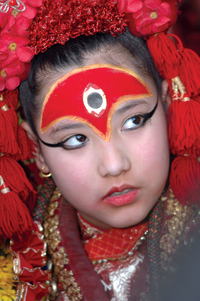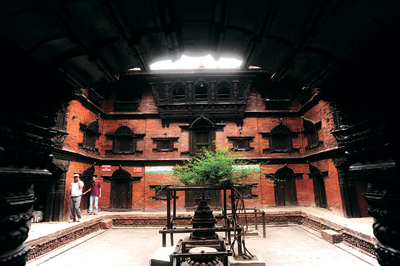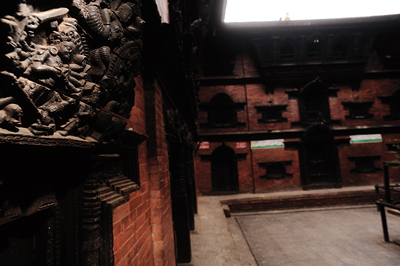Kumārarūpā Kaumarī mayūravaravāhanā Raktavastradharā tad vacchūlaśaktidharā mata
 The Matsya Purana, one of the eighteen puranas of ancient Hindu mythology describes the image of Kaumari as the female counterpart of Lord Kumar, sitting upon a peacock (vahan), clad in red cloth and possessing sakti and sula as her weapons. Even the Kumari Tantra describes the Goddess Kumari in the same red form. She is also taken as one of the eight Matrikas (Ashta matrika) and nine Durgas (Nava Durga), and is respected as a mother-figure in both Hinduism and Buddhism.
The Matsya Purana, one of the eighteen puranas of ancient Hindu mythology describes the image of Kaumari as the female counterpart of Lord Kumar, sitting upon a peacock (vahan), clad in red cloth and possessing sakti and sula as her weapons. Even the Kumari Tantra describes the Goddess Kumari in the same red form. She is also taken as one of the eight Matrikas (Ashta matrika) and nine Durgas (Nava Durga), and is respected as a mother-figure in both Hinduism and Buddhism.
Goddess Kumari is worshipped in many different forms around the world. The Indian version worships the Kumari in a living child on special occasions in Dusshera (the tenth day of Dashain festival) and elsewhere in the form of an idol. The Nepal Mandal (i.e. the Kathmandu valley along with organized Newar settlements in the outskirts of the valley), also has its unique version of the worship of the mother-goddess, Kumari, in the living form.
Kumari Chhen
The Mallas of the Kathmandu valley were great patrons of the Goddess Taleju Bhawani. Legend has it that they even met the goddess in person and often talked and played tripasa (a traditional game played using two dices by moving pieces corresponding to the numbers over a piece of cloth divided into various squares) with her. But, in course of time, over same misbehaviour with the mother-deity or due to a heinous crime a king got stripped off the rights to see the goddess in person. Lately, when the king apologized to the goddess during a tantric ceremony, the goddess finally agreed to be hosted in the body of a young Shakya girl, who was subsequently entitled to take the office of a royal Kumari.
Then, according to the promises made to her, the foundation of the Kumari Ghar was laid in Nepal Sambat 877 Falgun (1757 AD). An annual chariot procession of Kumari along with those of Lord Ganesh and Bhairab too was started then.
 Architectural Outlook
Architectural Outlook
The Kumari Chhen (Newari name for Kumari Ghar) is typically in the shape of a typical vihar dedicated to Buddhism. Though it is commonly called Kumari Baha or Kumari Temple, it is also gets its name in respect to Boddhisatva (i.e. near Buddhas) — Rajkiriti Manoram Mahavihar. Renowned expert, Mary Slusser, however, attributes the temple with the name Rajlakshmikula vihara, where the royal (state or Raj) Kumari resides and has her shrine established.
This is true in case of other Kumari houses as well. Almost every Kumari is associated to specific vihars, whether or not they are permanent residents there. For instance, the abode of Kumari in Patan at Haka Bahal is called Ratnakar Mahavihar. In Bhaktapur, the Yekanta Kumari resides in Chaturvarna Mahavihar or Dipankar Vihar. In Chabahil, she is associated to Suvarnapurna Mahavihar or Charumati Vihar. This also applies to the living Kumari of Kilagal, Kwabahal, Mubahal, Tanabahal, Bungamati and so on.
The Kumari ghar of Kathmandu lies south-west of the Hanuman Dhoka Durbar Square compound next to the Sikha Mubahal, in front of Trailokyamohan-narayan temple (commonly called Dash-Avatar Mandir) and Gaddi Baithak. The eastern face of Kumari Ghar has an open façade at the south-eastern corners of which houses the Kathmandu Metropolitan Hanuman Dhoka Conservation Programme Office and Nava Adarsha School. Towards the south of the Kumari Ghar is Gwachhemuga Galli connecting Freak Street with Singha Satal. The front façade facing north is decorated with ornate woodcrafts of medieval period. Atop this north face on the roof covered with terra cotta tiles is the pinnacle (gajur). This pinnacle is different than common ones found on most some temples as it has one pinnacle slightly bigger than two identical sized pinnacles on either side. From the pinnacle hangs a long gold-plated strip called pata.
The building is surrounded both inside and outside by a wider plinth covered with bricks and stones. They now host a resting place for passers-by and a store for wooden logs of the chariot used during the annual Kumari procession in Indra Jatra. This three-storey chariot is placed adjacent to Kumari Ghar. Another small chariot called the Viman Khat (meant to be carried on shoulders) is placed at the open eastern side under a small enclosure made especially for the chariot.
 The ground floor has exquisitely carved doors with tympanums worked with equal mastery. Among the three doors, only the middle one is open. The stone steps leads to the main door and has two life-size lions placed on either sides as guards to both, the temple and the deity. The northern side has 22 exquisitely carved windows in various forms. There are a total of 11 Tiki Jhyas or Akhi Jhyas, three Ga Jhyas, two Chakla Jhyas and six Sa Jhyas. The main Ga Jhya directly over the main entrance is gold-plated in the centre and it is believed that no one but the Kumari can only see outside this window. This Kumari Jhya was established with tantric rituals on the occasion of Varshabandhan puja (annual worship) in Nepal Sambat 878 Ashwin (i.e. AD 1758) by king Jaya Prakash Malla and queen Dayalakshmi Devi. This window is again elegantly carved with 39 flying-horses at the bottom.
The ground floor has exquisitely carved doors with tympanums worked with equal mastery. Among the three doors, only the middle one is open. The stone steps leads to the main door and has two life-size lions placed on either sides as guards to both, the temple and the deity. The northern side has 22 exquisitely carved windows in various forms. There are a total of 11 Tiki Jhyas or Akhi Jhyas, three Ga Jhyas, two Chakla Jhyas and six Sa Jhyas. The main Ga Jhya directly over the main entrance is gold-plated in the centre and it is believed that no one but the Kumari can only see outside this window. This Kumari Jhya was established with tantric rituals on the occasion of Varshabandhan puja (annual worship) in Nepal Sambat 878 Ashwin (i.e. AD 1758) by king Jaya Prakash Malla and queen Dayalakshmi Devi. This window is again elegantly carved with 39 flying-horses at the bottom.
Except the two Aakhi Jhyals and a set of three Sa Jhyals in the eastern façade, there are no other elaborate windows. The southern façade has simple windows.Lacking ornate woodwork and the western side has no windows as it is attached to Sikha Mubaha.
Inside the Kumari Ghar is an open courtyard (or bahal) in the midst of which is a chaitya (locally called the Chiba Dya). The stone chaitya, as many other chaityas in the Nepal Mandal, is crafted with Pancha Buddhas or Five Buddhas. The bahal also contains the two Chakras one of which is carved with the tantric Kumari Yantra.
In a typical Newar residential style, the Kumari Chhen can be distinguished as Chhidi (the ground floor), Maatan (the first floor), Chwata (the second floor) and the roof. Straight inside the bahal is a long passage wherein five Buddhas namely Vairochan Buddha, Amitabh Buddha, Amogh Siddhi Buddha, Akshyobhya Buddha and Ratna Sambhav Buddha are established.
 Directly over this, at the second floor is another Sa Jhya from where the Living Goddess gives a short glimpse everyday to the devotees.
Directly over this, at the second floor is another Sa Jhya from where the Living Goddess gives a short glimpse everyday to the devotees.
Before stepping down into the bahal, there are two holes on either side of the walls which are worshipped as Nasadya (the god of dance and other arts) and Mahankal Bhairav especially in annual Varshabandhan.
At the top floor is the grand throne of the living goddess. Set in a special room, the golden throne is carved with peacock as the seat (aasan). On the final day of Indra Jatra and in Dashain, devotees worship the Goddess Kumari seated on this throne in this room.
Alongside this magnificence, terra cotta images carved at the plinth of the bahal too bear artistic excellence. However, the story to those carvings has not been worked out.
Wall Paintings
The house of the living goddess has walls that are artistically painted with many different religious crafts. The wall paintings are found only inside the Kumari Ghar, wherein one can find rare and colorful paintings of gods and goddesses belonging to various tantric traditions like Mahaganesh, Mahabhairav, Mahakumari, Vaishnavi, Tulaja Bhawani, Mahavarahi, Mahaindrayani, Mahachamunda, Mahalaxmi, Mahabrahmayani and Manamaheshwori.
The life-size painting of king Jayprakash Malla with hands folded in due respect to the goddess can also be found here. The king is shown at the right foot of the Goddess Taleju, whereas the queen Dayalakshmi is shown at the left foot along with prince Jyotiprakash Malla. These paintings portray the deep respect of the royal family to the goddess Taleju Bhawani and, ultimately, to the living goddess Kumari.
Similarly, there are wall paintings dedicated to four Matsyendranath (Karunamaya or Lokeshwor) of the Kathmandu Valley, viz. Padmapani Lokeshwor (Rato Matsyendranath, Lalitpur), Vajrapani Lokeshwor (Seto Matsyendranath, Kathmandu), Anandadi Lokeswhor (Adinath, Chobhar) and Shristikanta Lokeshwor (Nala Matsyendranath). Also the wall paintings of Swoyambhunath Stupa, Hanuman, Narsingha, Pachali Bhairav, Kal Bhairav, Bagh Bhairav of Kirtipur, Dolakha Bhimsen, Dakshinkali and other yog-yogini (demi gods and goddesses) have been placed in the Kumari Ghar.
These wall-paintings adhere to the fact that medieval Nepal respected all religions and cults, and so does the abode of the living goddess, Kumari Ghar.
Dambar Kumari and a fabric that transcended boundaries
Photo Credit: Chandra S. Magar Dambar Kumari was a rebel who did not want...









